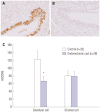Decreased Progesterone Receptor B/A Ratio in Endometrial Cells by Tumor Necrosis Factor-Alpha and Peritoneal Fluid from Patients with Endometriosis
- PMID: 27593876
- PMCID: PMC5011280
- DOI: 10.3349/ymj.2016.57.6.1468
Decreased Progesterone Receptor B/A Ratio in Endometrial Cells by Tumor Necrosis Factor-Alpha and Peritoneal Fluid from Patients with Endometriosis
Abstract
Purpose: Progesterone resistance is thought to be a major factor that contributes to progression of endometriosis. However, it is not clear what causes progesterone resistance in endometriosis. This study aimed to assess whether cytokines or peritoneal fluid can affect progesterone receptor (PR) expression in endometrial cells and to verify whether PR expression is reduced in endometriosis.
Materials and methods: The PR-B/A ratio was measured via real-time polymerase chain reaction after in vitro culture, in which endometrial cells were treated with either tumor necrosis factor-alpha (TNF-α), interleukin-1 beta, or peritoneal fluid obtained from women with advanced-stage endometriosis. Immunohistochemistry was performed to compare PR-B expression between eutopic and ectopic endometrial tissues from women with and without advanced-stage endometriosis.
Results: The PR-B/A ratio was significantly decreased by treatment with either TNF-α (p=0.011) or peritoneal fluid from women with advanced-stage endometriosis (p=0.027). Immunoreactivity of PR-B expression was significantly lower during the secretory phase than during the proliferative phase in endometrial tissues from control subjects (p<0.001). PR-B expression was significantly reduced in the eutopic endometrium (p=0.031) and ovarian endometrioma (p=0.036) from women with advanced-stage endometriosis compared with eutopic endometrium tissues from control subjects.
Conclusion: Progesterone resistance in endometriosis may be caused by proinflammatory conditions in the pelvic peritoneal microenvironment.
Keywords: Endometriosis; cytokine; endometrium; peritoneal fluid; progesterone receptor.
Conflict of interest statement
The authors have no financial conflicts of interest.
Figures




Similar articles
-
Abundance and Localization of Progesterone Receptor Isoforms in Endometrium in Women With and Without Endometriosis and in Peritoneal and Ovarian Endometriotic Implants.Reprod Sci. 2015 Sep;22(9):1153-61. doi: 10.1177/1933719115585145. Epub 2015 Jun 2. Reprod Sci. 2015. PMID: 26037298 Free PMC article.
-
Increased nuclear expression of nuclear factor kappa-B p65 subunit in the eutopic endometrium and ovarian endometrioma of women with advanced stage endometriosis.Am J Reprod Immunol. 2013 Dec;70(6):497-508. doi: 10.1111/aji.12161. Epub 2013 Oct 3. Am J Reprod Immunol. 2013. PMID: 24118362
-
Progesterone Resistance in Endometriosis: an Acquired Property?Trends Endocrinol Metab. 2018 Aug;29(8):535-548. doi: 10.1016/j.tem.2018.05.006. Epub 2018 Jun 19. Trends Endocrinol Metab. 2018. PMID: 29934050 Review.
-
Regulation of P21-activated kinase-4 by progesterone and tumor necrosis factor-α in human endometrium and its increased expression in advanced-stage endometriosis.J Clin Endocrinol Metab. 2013 Feb;98(2):E238-48. doi: 10.1210/jc.2012-2969. Epub 2013 Jan 4. J Clin Endocrinol Metab. 2013. PMID: 23293332
-
Role of nuclear progesterone receptor isoforms in uterine pathophysiology.Hum Reprod Update. 2015 Mar-Apr;21(2):155-73. doi: 10.1093/humupd/dmu056. Epub 2014 Nov 18. Hum Reprod Update. 2015. PMID: 25406186 Free PMC article. Review.
Cited by
-
New therapeutic approaches for endometriosis besides hormonal therapy.Chin Med J (Engl). 2019 Dec 20;132(24):2984-2993. doi: 10.1097/CM9.0000000000000569. Chin Med J (Engl). 2019. PMID: 31809322 Free PMC article. Review.
-
Evaluation of Proinflammatory Cytokines Concentrations in Plasma, Peritoneal, and Endometrioma Fluids in Women Operated on for Ovarian Endometriosis-A Pilot Study.Int J Mol Sci. 2025 May 26;26(11):5117. doi: 10.3390/ijms26115117. Int J Mol Sci. 2025. PMID: 40507929 Free PMC article.
-
Human V 7.2-J 33 mucosal-associated invariant T cells in endometrial ectopic tissues tend to produce interferon-gamma: A new player in endometriosis etiology: A case-control study.Int J Reprod Biomed. 2024 May 15;22(3):235-244. doi: 10.18502/ijrm.v22i3.16168. eCollection 2023 Mar. Int J Reprod Biomed. 2024. PMID: 38868448 Free PMC article.
-
MicroRNAs and Progesterone Receptor Signaling in Endometriosis Pathophysiology.Cells. 2022 Mar 24;11(7):1096. doi: 10.3390/cells11071096. Cells. 2022. PMID: 35406659 Free PMC article. Review.
-
Relaxin-2 May Suppress Endometriosis by Reducing Fibrosis, Scar Formation, and Inflammation.Biomedicines. 2020 Oct 31;8(11):467. doi: 10.3390/biomedicines8110467. Biomedicines. 2020. PMID: 33142814 Free PMC article.
References
-
- Eskenazi B, Warner ML. Epidemiology of endometriosis. Obstet Gynecol Clin North Am. 1997;24:235–258. - PubMed
-
- Giudice LC, Kao LC. Endometriosis. Lancet. 2004;364:1789–1799. - PubMed
-
- Eisermann J, Gast MJ, Pineda J, Odem RR, Collins JL. Tumor necrosis factor in peritoneal fluid of women undergoing laparoscopic surgery. Fertil Steril. 1988;50:573–579. - PubMed
-
- Hill JA, Anderson DJ. Lymphocyte activity in the presence of peritoneal fluid from fertile women and infertile women with and without endometriosis. Am J Obstet Gynecol. 1989;161:861–864. - PubMed
MeSH terms
Substances
Supplementary concepts
LinkOut - more resources
Full Text Sources
Other Literature Sources
Medical
Research Materials

